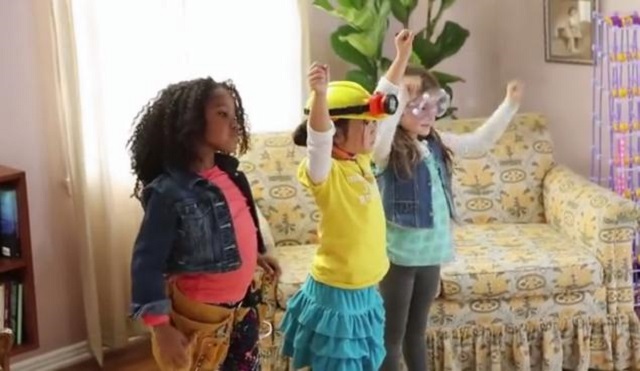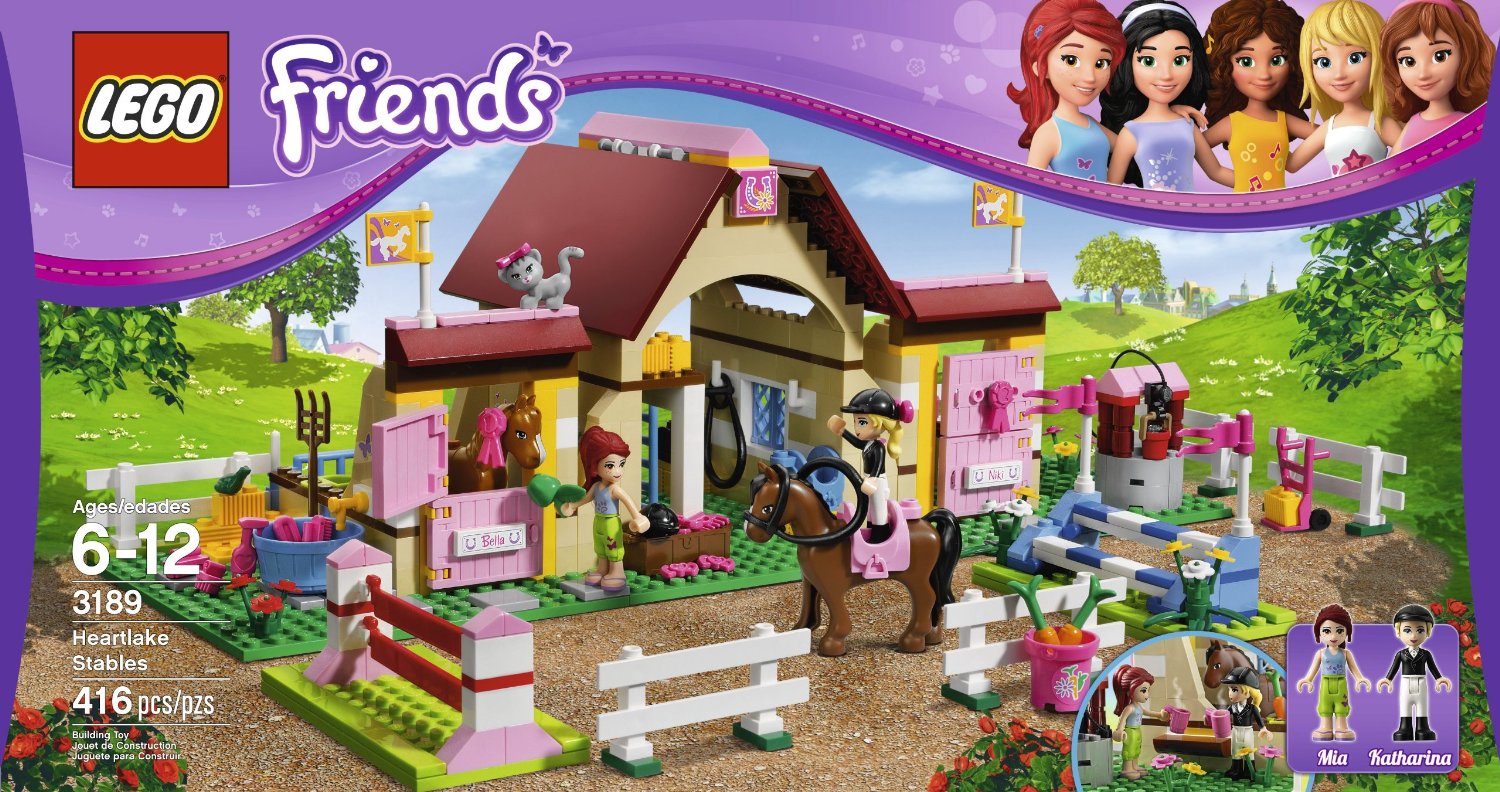by C.J. Pascoe and Tristan Bridges
As feminist parent-scholars we’d like to call for an end to (or at least a pause in) the seeming incessant focus on rejecting all that is pink, salmon, rose, coral, blush, and flush. As much of nation recovers from the frantic collective shopping spree that characterizes the end of the year, we’d like to make the case that the denunciation of all things pink should not really be our primary focus if we want to move toward a more gender equal world for girls and boys. Instead, we suggest that we begin to turn our attention to expanding the acceptable range of boys’ toys and their colors.
 Many of us who think about gender and childhood toys are by now familiar with the debate about GoldieBlox, a toy company that sells products encouraging girls’ interest in engineering. The company’s commercial depicting girls deploying a Rube Goldberg-type setup with the typical girl toys—princesses, dolls, teacups, and oh-so-much pink—was seen as both inspirational and problematic. Commentators both celebrated the fact that girls were being encouraged to engage in engineering and critiqued the fact that that the products marketed by the company are still firmly framed in terms of girl culture.
Many of us who think about gender and childhood toys are by now familiar with the debate about GoldieBlox, a toy company that sells products encouraging girls’ interest in engineering. The company’s commercial depicting girls deploying a Rube Goldberg-type setup with the typical girl toys—princesses, dolls, teacups, and oh-so-much pink—was seen as both inspirational and problematic. Commentators both celebrated the fact that girls were being encouraged to engage in engineering and critiqued the fact that that the products marketed by the company are still firmly framed in terms of girl culture.
The cultural process of “pinkification” (as Gwen Sharpe refers to it) is a way in which toys and forms of play which may have been historically associated with boys are rendered acceptably feminine. Indeed many, us included, are concerned with toys marketed to girls that are a larger part of a socialization process that encourages girls to be nice, passive and relationship-oriented. As Ellen Seiter notes in her book Sold Separately, “advertisements for girls’ toys have undergone fewer changes than other toys in the past fifty years because they continue to depict girls’ play as a miniature version of their mothers’ domestic work” (74).  Luckily Pottery Barn simply leads with this sort of gender stereotyping in its toy section (placing gender “neutral” toys at the bottom of its boys and girls pages), even as it divides up its offerings by gender.
Luckily Pottery Barn simply leads with this sort of gender stereotyping in its toy section (placing gender “neutral” toys at the bottom of its boys and girls pages), even as it divides up its offerings by gender.
We find it a little concerning, however, that this discussion is so focused on girls. What would this discussion look like if we examined boys’ toys? What might this conversation look like if we focused not on getting rid of pink, princesses, or housekeeping toys, but on making these toys acceptable for everyone to play with. After all, as others have pointed out, this “pink is for girls” thing is a relatively new development. In her book Pink and Blue, Jo Paoletti details the historic transformations involved in gendering these two colors. While a brief look at JeongMee Yoon’s The Pink and Blue Project vividly illustrates the extent of this transformation, there’s no reason that color coding toys by gender couldn’t undergo future evolutions (especially with consumer pressure). Indeed, organizations like Let Toys Be Toys are fighting to get retailers to stop promoting toys as “for girls” or “for boys” and some toy stores are starting to try to make changes.
 The focus on the push back against pink and, by extension, princess culture is especially surprising when one looks at what is for sale in the boys’ aisle. Take the first category of offerings for boys at the Toys R Us website for example – action figures laden with a variety of weapons who are designed to defeat the bad guys. The closest offering for girls is a dolls category – featuring Barbies, the Little Mermaid, and Strawberry Shortcake. None of them are warriors. None of them have weapons. We see a similar difference even when looking at the exact same category: Girl’s Building Sets vs. Boy’s Building Sets. Girls apparently build houses, salons… and the occasional bridge. Boys? They build Super Star Destroyers and Monster Fighter Vampyre Castle… and the occasional bridge. To be clear, the “pink aisle” of toy stores is deeply problematic. It encourages a narrow range of passive, primarily family-oriented and appearance-obsessed femininities. But, as the toys on the (digital and physical) shelves indicate, we are encouraging equally restrictive and arguably more dangerous masculinities – warriors, space fighters, and ninjas.
The focus on the push back against pink and, by extension, princess culture is especially surprising when one looks at what is for sale in the boys’ aisle. Take the first category of offerings for boys at the Toys R Us website for example – action figures laden with a variety of weapons who are designed to defeat the bad guys. The closest offering for girls is a dolls category – featuring Barbies, the Little Mermaid, and Strawberry Shortcake. None of them are warriors. None of them have weapons. We see a similar difference even when looking at the exact same category: Girl’s Building Sets vs. Boy’s Building Sets. Girls apparently build houses, salons… and the occasional bridge. Boys? They build Super Star Destroyers and Monster Fighter Vampyre Castle… and the occasional bridge. To be clear, the “pink aisle” of toy stores is deeply problematic. It encourages a narrow range of passive, primarily family-oriented and appearance-obsessed femininities. But, as the toys on the (digital and physical) shelves indicate, we are encouraging equally restrictive and arguably more dangerous masculinities – warriors, space fighters, and ninjas.
 So why isn’t the gunnification of boys culture the locus of discussion? It has a lot to do with our fear of boys’ gender transgressive behavior. Emily Kane gives us important insight about the power of this fear. In interviewing parents about their responses to their children’ gender nonconformity she finds many parents actively support some atypical behaviors in their sons. But, this acceptance and support is usually tempered by efforts to ensure that he conforms to masculine ideals in other ways. Importantly, parents of young children express more concern that gender nonconformity in their sons (but not necessarily daughters) is an indicator of a future non-heterosexual identity. A rejection of femininity is part of socializing boys to be acceptably masculine. As Kane writes, “Most parents made efforts to accomplish, and either endorsed or felt accountable to, an ideal of masculinity that was defined by limited emotionality, activity rather than passivity, and rejection of material markers of femininity.” Thankfully, some have begun to imagine what gender progressive parenting practices would actually look like.
So why isn’t the gunnification of boys culture the locus of discussion? It has a lot to do with our fear of boys’ gender transgressive behavior. Emily Kane gives us important insight about the power of this fear. In interviewing parents about their responses to their children’ gender nonconformity she finds many parents actively support some atypical behaviors in their sons. But, this acceptance and support is usually tempered by efforts to ensure that he conforms to masculine ideals in other ways. Importantly, parents of young children express more concern that gender nonconformity in their sons (but not necessarily daughters) is an indicator of a future non-heterosexual identity. A rejection of femininity is part of socializing boys to be acceptably masculine. As Kane writes, “Most parents made efforts to accomplish, and either endorsed or felt accountable to, an ideal of masculinity that was defined by limited emotionality, activity rather than passivity, and rejection of material markers of femininity.” Thankfully, some have begun to imagine what gender progressive parenting practices would actually look like.
Gloria Steinem is quoted as having said, “We’ve begun to raise daughters more like sons… but few have the courage to raise our sons more like our daughters.” Maybe the war on pinkification isn’t the one we should be fighting. Or at least we need to add to it a focus on the toys that we market to boys. The fact that boys are being socialized into violence and dominance is at least as problematic as the domestic and relational roles that are being marketed to girls. Rather than focusing so much energy on pink, perhaps we should be working on opening up rainbows of every color and toy for ALL children.


Comments 15
Darlene — January 1, 2014
I agree that the "gunification" of boys' toys is a major problem, but it's not separate from the problems with girls' toys. All children are being pushed towards toys that don't teach them useful skills for living in a civilized society. There is no practical middleground, kids are introduced to mass media and pop culture at very early ages, and parents - perhaps feeling guilty about how much they rely on tv for babysitting - overindulge their children's whims, which are largely formed by media and peer pressure the kids don't have the capacity to understand. Letting your kid obsess about guns OR princesses or believing it's a natural product of their biological sex is a copout and a dereliction of parental responsibility.
There's a big difference between domestic toys like cooking and housecleaning sets and princess toys. The former should be marketed to all children along with messages of respect for the value of domestic work. Princess toys, like war toys, are deeply problematic for reasons that stretch beyond gender. They encourage materialism, snobbery, entitlement, laziness, and a terribly limiting view of the value and potential of both men and women. There is nothing practical or constructive about raising any child to fantasize about being a member of an idol aristocracy that contibutes nothing to society and oppresses the working classes. Princess girls grow up to use the passive-aggressiveness they learned to encourage warrior boys to instigate more acts of violence and oppression (and put themselves at undue risk to impress their "princess"). Nobody wins.
Guns and princesses aren't separate battles. They're complimentary parts of a plot to get middle and working class children caught up in fantasies about a reggressive medieval society (albeit with modern weapons) and perpetually fighting a "battle of the sexes" within their own homes instead of recognizing the real threats to working people posed by the corporate oligarchy.
T.K. — January 1, 2014
Eh, it's genetic. It is our survival instinct to want our bloodlines to continue, which is more likely if our offspring mate with the opposite sex.
Margaret Middleton — January 1, 2014
Thank you for bringing up these issues which are so rarely heard!
You make so many excellent points in this article, and I found myself nodding along vehemently to everything *except* your premise that we should "stop the war on pink". How does the rejection of the way toys are marketed to girls in any way detract from "opening up rainbows of every color and toy for ALL children"?
"Pink" is often a decoy in these conversations- those who rail against pink are never saying they are against it as a color (that's absurd), they are simply sick of seeing a monochromatic representation of girlhood (and womanhood for that matter). This is about creating better options for toys that do not limit our children's imaginations and identities and the fight for better options for girls is not in conflict with that greater goal.
Does the “War on Pink” need to stop for boys’ sakes? No, and here’s why. | Rebecca Hains — January 1, 2014
[…] a recent blog post on Girl w/Pen, professors CJ Pascoe and Tristan Bridges—sociologists whose work focuses on […]
Rebecca Hains — January 1, 2014
As a girls' studies scholar and a girl empowerment activist, this piece rubs me the wrong way. Why should we stop or pause our work on girl culture to focus on boys' issues? Critiquing children's culture is not a zero-sum game of the boys versus the girls. Both sets of issues are valid, and both can be addressed by people with expertise in their respective areas--simultaneously.
It's absurd to suggest that my colleagues and I ought to change course. Just as you can and should continue your work on masculinities, I'll continue doing my work on girlhood.
I've elaborated on this response at my blog, at http://rebecahains.wordpress.com/2014/01/01/does-the-war-on-pink-need-to-stop-for- boys-sakes-no-and-heres-why/ Please check it out if you can; I hope you'll give it some thought.
Boys and Girls, This Isn’t a Zero-Sum Game — January 2, 2014
[…] when an article came out yesterday telling people like myself and my colleagues to stop focusing on girls and Pink […]
#confuzzled — January 3, 2014
If little girls didn't enjoy pinkification, then companies would have no reason to spend money to engage in it.
If little boys didn't enjoy gunification, again, companies would have no reason to spend money to engage in it.
Companies are just providing what they think consumers want. Lego has absolutely no problem with girls enjoying Super Star Destroyers, it's just that girls do not seem to want Super Star Destroyers, so Lego is struggling to find an alternative that many girls will actually enjoy. Thus, pinkification.
If you think this is bad, blame the consumers.
Grounded Parents | From the Front of Another Fictional War – Pink! — January 4, 2014
[…] for another year’s War on Christmas, a new battle cry has been sounded for 2014 – “Stop the War on Pink!” cries this piece, with a subhead that barely avoids every online feminist’s favorite phrase, […]
Back to Pink, Kind of. | yourbabynanny — January 16, 2014
[…] “Who’s Afraid of the War on Pink” reads, to me and my colleagues, like a straw man argument. The authors were conjuring up a nonexistent epidemic of myopic thinking, instead of engaging with anyone’s […]
Brad Tullis — April 27, 2014
Wow.... so much garbage in this article I dont know where to start. So toy manufacturers force parents to buy designated toys for their sons or daughters? That makes no sense. Toy manufacturers like any other type of company, could care less which gender: their product was purchased for. 20 manufacturers like any other company, want to produce products that sell! Toy manufacturers do not have an agenda that they set out to dictate what boys and girls play with. That's insane! Generally speaking, boys prefer loud, rugged, tough, action packed, mind provoking type: Torres. That's just the nature of the male brain. Generally speaking girls don't prefer the same type of toys that boys prefer. Their brains are wired differently. I had the choice many times in my life to choose what toys I would play with as a child. My grandparents house for instance, they had a closet that was just full of toys. All kinds of toys and games. Everything from dolls to trucks, Barbies to Legos, coloring books to guns... you name it. after scurrying through this closet, on many occasions mind you, I don't think I ever once had any desire to play with the typical girls toys. I preferred the trucks, tractors, erector sets, guns, tanks, army men etc... those were my choice. I wasn't pushed to play with anything. That's where my interest was.my sister and other girl cousins were typically just the opposite of me. They didn't use the same toys to play with that I did.
Why can't people like you understand that boys and girls are wired differently and have often completely different preferences? Why do boys and girls have to be the same in your mind?boys and girls will always think differently, and react differently in any given situation. if you could only accept the fact that the male and female gender are different from each other, your life would be a heck of a lot more simple
doideunu.ro — January 7, 2017
Aw, this was an extremely nice post. Taking the time and actual effort to create a superb article… but what can I say… I hesitate a whole lot and never manage to get anything done.